Into the AfterMAX.
737-MAX: The Fix Is In? (Premise).
The 737 MAXs are minimized, airline fleets gutted, leasing companies glutted, Boeing stock free falling— the FAA backtracking and testifying no end. Both the manufacturer and FAA are reduced to seeking an international stamp of approval going 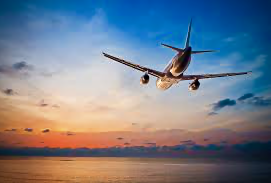 forward, with Canada already demanding extra simulator training—its and many other regulators worldwide indicating that they will require their own independent safety reviews prior to recertification.
forward, with Canada already demanding extra simulator training—its and many other regulators worldwide indicating that they will require their own independent safety reviews prior to recertification.
So, what’s it to us, right?
Firstly, it goes without saying how gravely the 346 victims and their shattered survivors have been affected by the entire MAXtastrophe, tragedies across 35 different countries, which only can be materially assessed and recompensed in designated chambers and courtrooms, for both the Lion Air JT610 and Ethiopian ET302.
Then there are the legions of airline employees, federal officials, Boeing workers and ancillary suppliers (GE Safran engines and UTC avionics to Senior airframes) who are not only stymied and squeezed by the MAX 8/9 failures and subsequent groundings, but shaken by the logistical and reputational damage done to a great, over century old aeronautical brand.
No denying that, as so much has been spoken and written about their aggregate anguish and plight. Yet where do the ‘afterMAX’ contrails leave us Vamigré travelers?
Shuffle Upon the Storm.
After all, a cloud has settled over a workhorse aircraft that serves nearly one third of U.S. domestic flights alone, the MAX flying 1,300+ runs per day worldwide. Consequently when upwards of 400 airplanes have been removed from carrier skies, displacement and disruptions are bound to take flight as well. Why, Southwest Airlines reports cancelling 10,000 flights in the first quarter alone. Norwegian Air, even more MAX laden, lost $171.5m in Q1, and will seek compensation from the manufacturer.
Shuffling and swapping airplanes, leasing other, often older substitute craft, the airlines must balance on-schedule, on-time service against operational downdrafts and soaring costs. They are at the mercy of wet-lease and operating lease operators such as Avion, Air Transport Services, TUI AG and IBA Aero, which rent out airliners on short notice (like Hertz or Avis) at sky-high daily, monthly, even multiyear rates.
Still, we are left with weighing cost, timeliness and convenience against the life-or-death safety of the very plane we may be boarding. Little wonder social media unleashed Facebook wallbanging and a Twitter storm that so quickly demanded the downing of MAX 8s well before the FAA or Boeing gave ground. Plaintive tweets and posts, however, can only get us so far…
Left Holding the Bags?
How, for instance, is this grounding period going to further impact on-time dependability, let alone the fee scourge/syndrome?
Most immediately, how are we to ascertain what sort of aircraft will a carrier have us flying these days? Especially now that it won’t be the latest 737 model, how old or overflown is the bird we’re boarding?
Do we take the tix/resv. sites’ word for it, whether the airlines’ or a third party’s—if not agents at the terminal counter or by phone? Should we go directly to aviation tracking sites and follow a given route by its specific flight code? Who has the time?
Who’s Flying What and When?
If you don’t like what you see plane wise at point of flight and seat selection, what leverage have you to go a different route, given that carriers have been trimming their fleets and schedules? And should you discover you are uncomfortably assigned after purchasing a ticket (electronic or paper), what is it likely to entail cancelling or changing course? Namely in terms of an airline’s change policies and fees, much less refunds and mandatory disclosure?
With today’s schedules being pared and tightened due to the MAX grounding, will we be facing more and increasingly abrupt carrier flight cancellations, lost baggage, bumping (voluntary or otherwise), lengthy wait lines (as in the 30-minute rule) and outright strandings? And what recourse or alternatives will we have through the grounding’s duration, should it extend through to the fall?
These issues are magnified all the more as spring breaks usher in the summer travel season, traffic and congestion building by the day. If the recent partial government shutdown is any indication, brace for 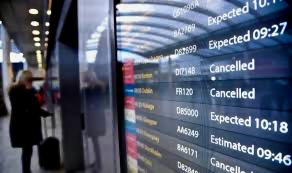 terminal disruption, longer wait times, tarmac delays, chaos gate to gate, flight to flight—not to mention the usual TSA checkpoint bottlenecks, TSA ‘Pre-Check’ notwithstanding.
terminal disruption, longer wait times, tarmac delays, chaos gate to gate, flight to flight—not to mention the usual TSA checkpoint bottlenecks, TSA ‘Pre-Check’ notwithstanding.
So much else to keep track of while the MAXtroversy roils on and myriad regulators clamp down. For one, European visa requirements are getting trickier with establishment of a European Travel Information & Authorization System on the horizon. The E.T.I.A.S., somewhat supplanting the standard visa, aims to bolster detection of security and sub-migratory crime risks—sort of a pre-check for border crossings. Registration will be required for travelers from over 60 nations who currently visit 26 EU member countries visa-free for more than 90 days (ETIAS fee: 7€, $8, for three years).
Trickier yet was the recent traveler ticket data glitch by AeroData. Or the FAA probe of Southwest Airlines’ sketchy calculations of luggage weight and balance, referred to by pilots computing their total aircraft weight. That is, flying fatter, with weight more errantly distributed by ramp crews in cargo bays, than agency safety regulations allow.
Then there are the incredibly shrinking cabin seats and restrooms, or those sneaky little seatback camera/monitors posing as inflight entertainment systems, amassing yet more data on us all.
Standards and Strategies vs. Cynicism.
Point being, in this uncertain MAXified grounding period, the rigidity and certitude of a Flyers Rights ‘Bill of Goods’ and D.O.T. dictums hold only so much sway. Which is why detailed Vamalytics will be quantifying and qualifiying comparative data on airline and ancillary industry performance, tix/resv. fare dealing, loopholes, fee steals, compensation and accommodations vis-à-vis carriers, domestic and overseas. In fact, United Continental is already cashing in on the rising fleet capacity supply/demand imbalance by doubling its 2019 Q1 profit, a 6.2% total revenue increase to $9.6b and nearly 4% share price jump on the rosy report.
Thus our yield will be custom, concerted VamoStrategies to counter present grounding woes and vastly improve our prospects for safer, surer, more satisfying air travel according to Vamigré standards. 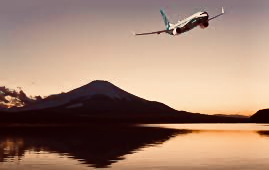
Because certain airline analysts hold that shareholders would jump all over them if there were no evidential reason to prolong the grounding (Boeing’s already reporting Q1 cash reserve losses of nearly $1b). That “the traveling public has had a very short memory of previous catastrophic crashes. Most people don’t even know what airplane they’re getting on, and their awareness of airworthiness issues has a lifespan of about three months.”
And to such coldly calculated industry arrogance, Vamigré says, ‘we will see about that…’
AfterMAX Update:
Boeing CEO, Dennis Muilenburg took the podium in Chicago April 29, facing an annual meeting of shaky shareholders, clear turbulence in the air.
At question were the platemaker’s credibility and commitment to safety as the 737 MAX downdraft intensifies—and MCAS’s remedial patches remain under a cloud of confusion and concern.
Meanwhile its airline customers such as Southwest grapple with soaring costs and stifled growth plans as their MAX 8’s are grounded going on two months, with no reinstated takeoffs on the horizon, the summer travel 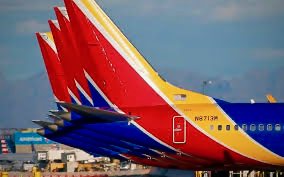 season circling and clearing to land. No doubt they will be demanding billions of dollars in compensation from Boeing for all their trouble.
season circling and clearing to land. No doubt they will be demanding billions of dollars in compensation from Boeing for all their trouble.
For its part, the FAA continues to face Congressional grilling over its cozy inspection ties with Boeing—plus accusations that it was remiss in directly monitoring 737 MAX 8 certification from the get-go. Thus the agency now vows a tough, thorough recertification process—not by the clock or the cost, but strictly by the book—even empaneling a technical advisory board to review the ‘MCAS fix’ once proposed.
Boeing itself is reeling under the strain of a drag on, drawn out MAX/MCAS redesign effort. Along with a 13% Q1 profit slide, investors paring $27b off the company’s market value, the aerospace giant must swallow a $11b hit to cover higher production expenses and other MAX-related costs. Add to that the looming liabilities relating to airlines, suppliers—not to mention LionAir/Ethiopian victims’ survivors. Then there are the civil/criminal fraud inquiries by the Department of Justice.
Further complicating Boeing’s fortunes going forward was the revelation that it neglected to inform its carrier customers that the MAX 8 lacked an alert/warning system featured on earlier 737 models, because it had been deactivated by the company itself. It did so without notice at that, even to its very own senior test pilots, much less federal regulators.
The alerts were designed to inform pilots should an angle-of-attack (AofA) vane be sending inaccurate data on their plane’s vertical and lateral pitch/attitude. But Boeing apparently had made the sensor alert ‘optional’ on MCAS-equipped MAX jets, apparently in the belief that the warning feature “did not adversely impact airplane safety or operation.” That “existing functionality was acceptable”; further, that such alerts could contribute to confusing “data saturation” and were “not an integral safety component.” Boeing had determined this as far back as 2017, but told neither its airline customers nor the FAA (which considered the issue ‘low risk’ anyway)—even after the Lion Air crash—and only copped to this omission upon outside media revelations.
More specifically, these “Disagree Alerts” function to warn cockpit crews (via colored lights) if, say two AofA readings are false, inconsistent or product of other malfunctioning sensor ‘vanes’. But perhaps since the MAX 8’s MCAS utilized a single AofA sensor, Boeing made the disagree alert—originally designed as a ‘stand-alone’ feature for inclusion on the main flight display panel—operative only on planes flown by airlines that had bought the optional ‘premium’ package. Even carriers that purchased the indicator set-up (some 20% of MAX customers) were misinformed on exactly how it operated, due to what the planemaker termed a “software mistake”, fixable in a “next planned update” that never came at least prior to the Ethiopian crash.
Add to that the tale of switching switches: wherein company engineers altered the standard 737 NG’s pair of trim toggle switches that govern positioning (angle) of the tail’s horizontal stabilizer by effectively cutting off its electronic control should runaway movement or malfunctions arise. For the MAX variant however, one of the switches, labeled ‘Auto Pilot’, was repurposed to basically duplicate the remaining toggle’s function—thereby hindering flight crews’ ability to easily deactivate MCAS—one step, without also having to press the yoke’s stabilizer thumb buttons. Again, design shortcutting led to cockpit confusion, as pilots were not adequately informed of the abandoned ‘auto’ function. So worst case, Ethiopian pilots were left with a more involved two-step trim switcheroo, along with the last-ditch hazard of wrestling with a manual trim wheel overmatched by horizontal tail forces.
Little wonder Boeing has lawyered up to the max with powerhouse firms amid the costly legal fallout (not least any criminal actions). Led by a long-time Boeing counselor and senior advisor to the CEO and board of directors, the MAX czar, a former appeals court judge, is spearheading efforts to throw out mounting lawsuits, or at least gain a more favorable change of venue.
Fail-Safe or Bust.
So shareholders and analysts pressed CEO Muilenburg on why the MAX/MCAS model was initially developed with a single-point-of-failure design. They wondered why the disagree alert was not operable on all Boeing aircraft; whether close cooperation between the company’s ‘authorized’ designee engineers and regulators (namely FAA types) spawned conflicts of interest, or whether pilot training will be fully computer based from now on. Lastly, investors asked how many $billions of bonds must the company sell to fund this all.
Muilenburg assured them that cost aside, “safety was Boeing’s top priority”, and that the MCAS ‘flight critical’ software development was always “consistent with our processes”, that “we don’t make safety features optional”. He went on to defend 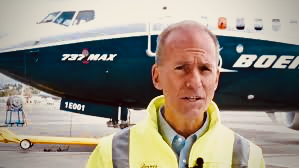 the initial MAX certification process, claiming that this MCAS fiasco was “no tech slip” but simply “an unfortunate chain of events”—that the disagree alert was not activated as intended: all of this couched in obligatory legalese.
the initial MAX certification process, claiming that this MCAS fiasco was “no tech slip” but simply “an unfortunate chain of events”—that the disagree alert was not activated as intended: all of this couched in obligatory legalese.
The CEO added in a follow up statement that necessary software fixes were mere weeks away, and once tested and certified, “each 737 MAX will have a fully activated and operable disagree alert and added AofA indicator” (still optional?). As a result, the MAX 8/9 “will be one of the safest airplanes ever to fly”, with comprehensive pilot training to match, before these planes will be wheeled out of airstrip purgatory and storage.
Better be, and sooner rather than later—because clocks and meters are running amid a ‘toxic drip’ of whistleblower or outside disclosures; the corporate brand is unraveling by the day; its suppliers are getting stretched and stressed by stalled income and inventory backlog. Besides, Airbus 320s continue nibbling at 737 MAX’s single-aisle market share, eating into Boeing’s pretzel packets and profit-party spread—even as the European manufacturer fears getting sucked into the regulatory safety scrutiny vortex itself.
Nevertheless, Muilenburg apparently beat back attempts to split his CEO-chairmanship roles, ostensibly mollifying the gathered investors. So he holds Boeing’s yoke with both fists for now. Vamigré will watch and see how long his first seat position flies in the MAXimally dramatic months ahead… (MTC…)
<< 737-8: The MAX Factors.
<<< Accident Update: Lion In Wait.
